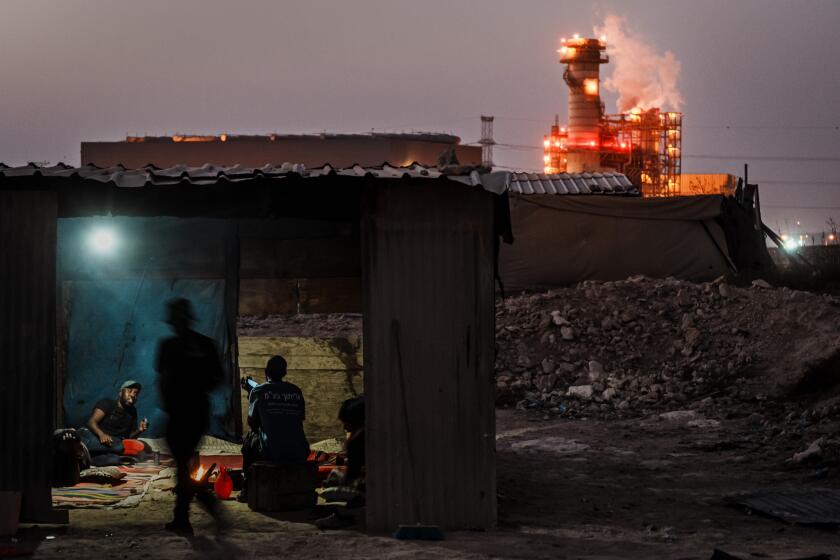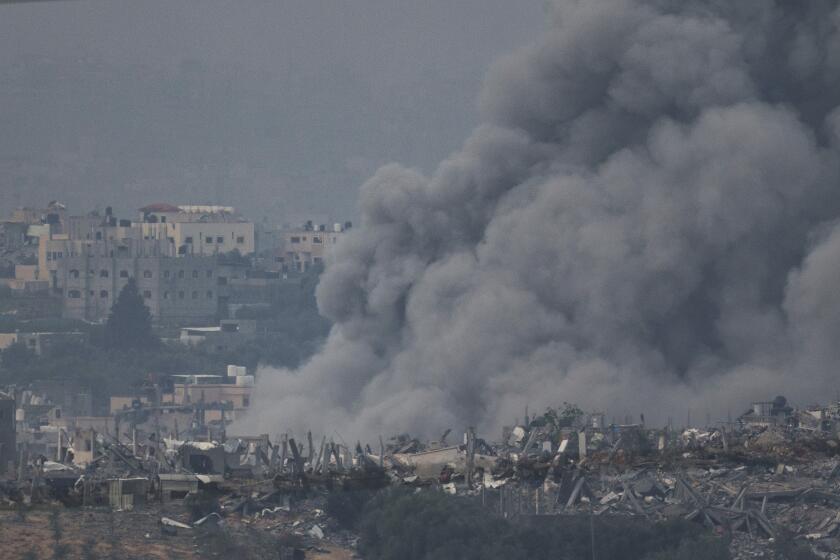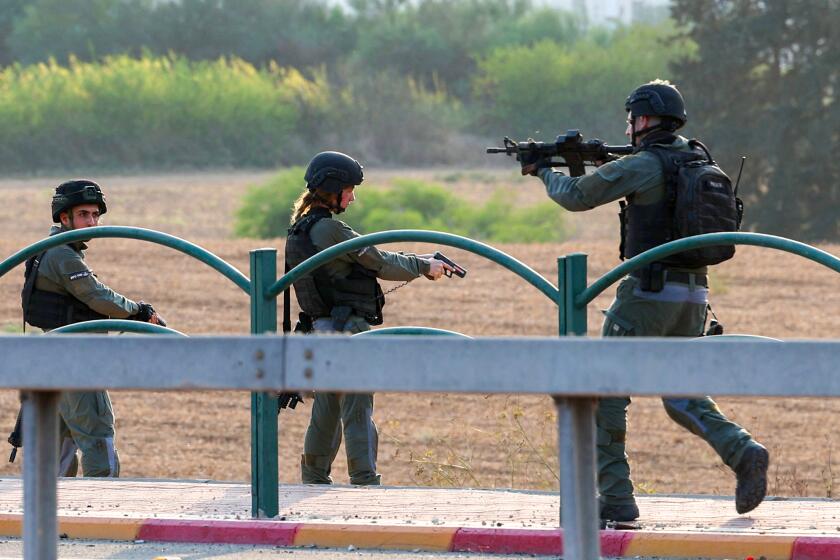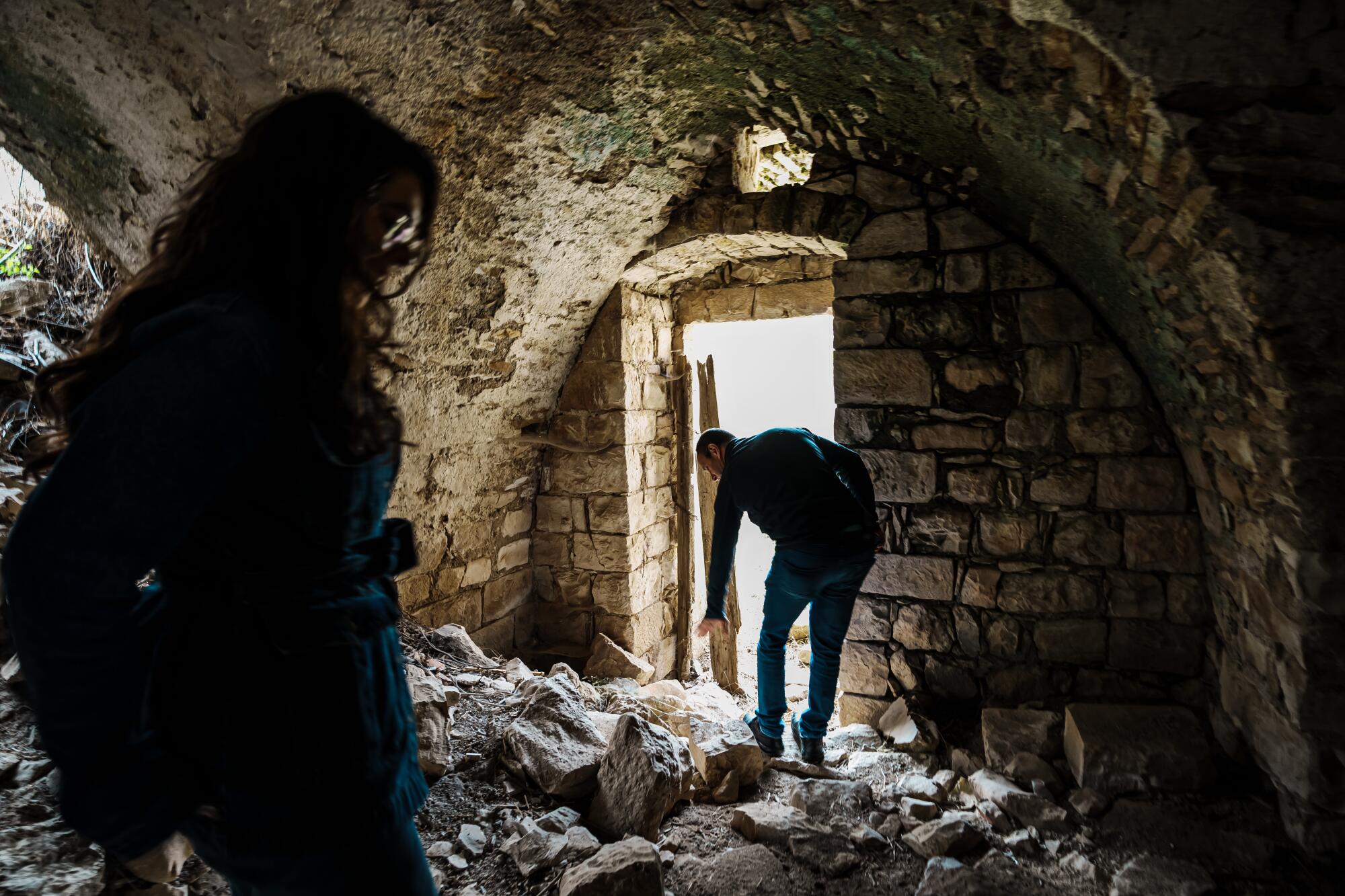
- Share via
JISH, Israel — Birds swoop across a valley separating Lebanon and Israel as olive and pomegranate trees rustle in the wind.
The flash of light from an opposing hillside looks small from a distance — until a boom cracks across the landscape, announcing another Hezbollah rocket launched toward Israel. Minutes later, more explosions peal through the air, as the Israeli military responds to the source of the fire.
Since the start of the Israel-Hamas war in Gaza Strip, hostilities have spread north to these hills, where Lebanon-based Hezbollah fighters have launched hundreds of missiles toward Israeli border communities, and Israeli forces have shelled targets to the north.
“This is happening every day,” said Shadi Khaloul, a Christian Aramaean activist, as he stands in a pastoral orchard in the northern Israeli town of Jish.
Aramaeans are a community of native Christians who trace their lineage to the time of Jesus. Khaloul has been instrumental in reviving spoken Aramaic, believed to be the language of Jesus and one used in portions of the Bible.
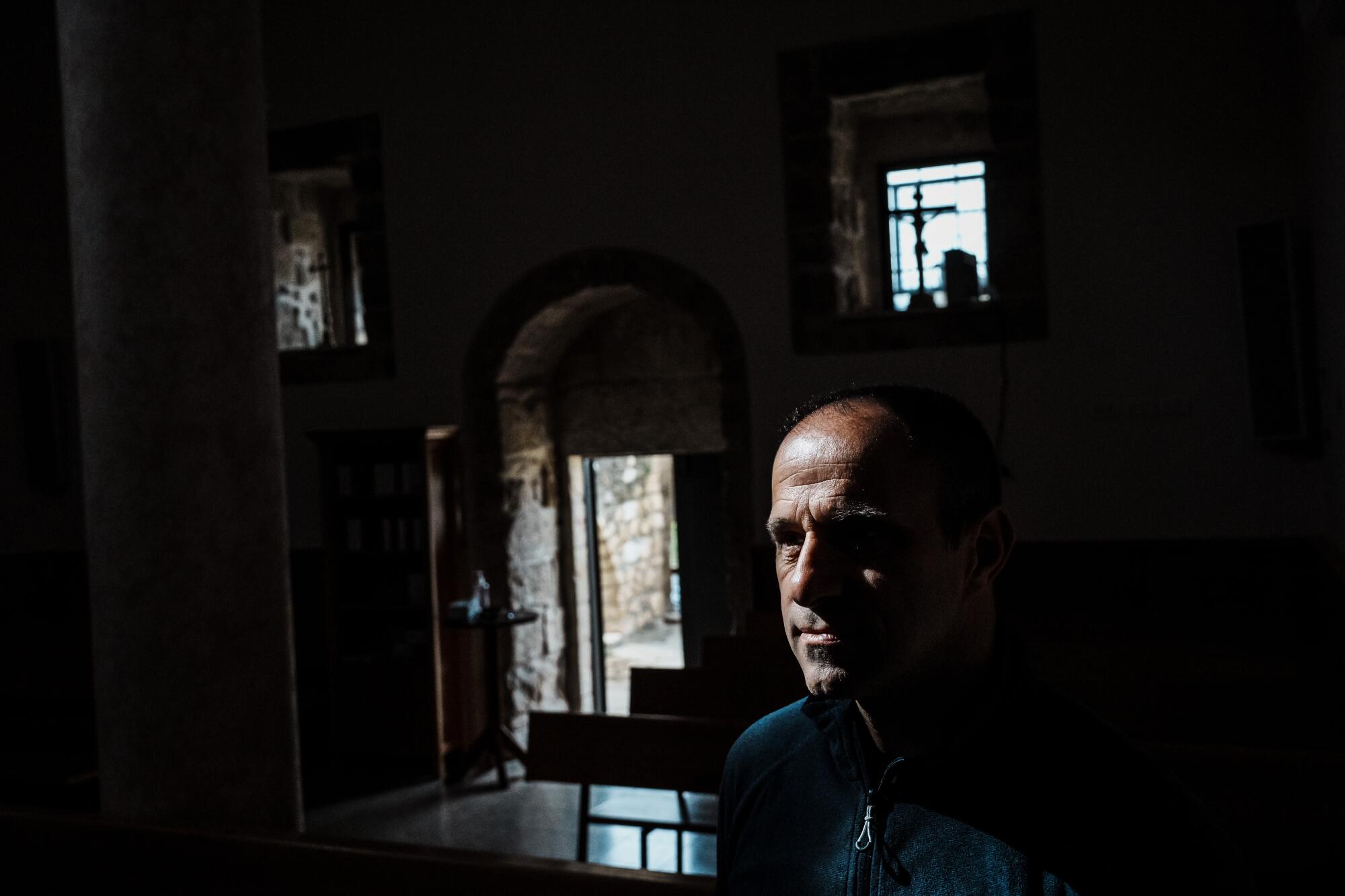
Like many Aramaeans in Israel, Khaloul has distant family in Lebanon. “I am worried both for my Christian community here in Israel, and for our brothers across the border,” he said, looking over the valley toward the southern Lebanese village of Maroun el Ras.
For the record:
11:01 a.m. Dec. 22, 2023An earlier version of this article incorrectly identified Maryam Younnes as an Aramean Christian. She is a Maronite Christian. The article also said that the Aramean Christian community numbers 15,000 in Israel, more than a million in Lebanon and more than 15 million worldwide. Those figures also include Maronite Christians, a closely related group.
For Maryam Younnes, a member of the closely related Christian Maronite community, the conflict is wrenchingly personal.
She was born in a small, rural Lebanese village called Debel. Her father was a commander in the Christian-dominated militia South Lebanon Army, which cooperated with the Israeli army during Israel’s 18-year occupation of southern Lebanon.
Many in Lebanon viewed members of the SLA as traitors and collaborators for fighting alongside Israel and against Hezbollah. Human rights groups accused the SLA of systematic torture and abuse of Lebanese prisoners at a facility it controlled.
When Israel withdrew from Lebanon in 2000, the SLA collapsed and many members and their relatives fled to Israel. Younnes and her family hoped to stay only a few days, until hostilities calmed down.
Twenty-three years later, her family is still there. The SLA members and their families were eventually offered and accepted full Israeli citizenship.
Bedouins of the Negev desert face rockets from Gaza and discrimination and arrest by Israel. They seek safety as the war energizes the far right.
She said she has been completely cut off from her extended family in Lebanon, with no communication since they left.
“The fact that my family is on the other side of the border, it’s not easy, because I know that they will get hurt if a broader war will happen,” Younnes said. “The southern Lebanese never wanted this war .... And then when the war is over, we are the ones who pay the price.”
Younnes said the villagers in southern Lebanon — many of whom are Christians — have little choice when Hezbollah militants set up military infrastructure, including rocket launchers, on their property, which puts them at risk for retaliation from Israel.
She blames Iran-backed Hezbollah — the militant group and Islamist political party with representatives in Lebanon’s government — for forcing her to stay in Israel. “For me, and for many Lebanese, Hezbollah is occupying Lebanon.”
Of the roughly 7,000 SLA members and their families who came to Israel, about 3,000 remain, Younnes said.
The others resettled in third countries or went back to Lebanon. Returning SLA officials faced prison sentences, though many family members were not prosecuted. They have struggled to reintegrate into Lebanese society.

In October, the Israeli government directed citizens living within 2½ miles of the Lebanese border to evacuate, including more than 30 towns and the city of Kiryat Shmona. At least 63,000 residents from the north are living in temporary accommodations in the center of the country, funded by the government at least until the end of the year. Nearly 70,000 additional Israelis were evacuated from their homes near the Gaza border.
Both Younnes and Khaloul live outside the evacuation zones and have stayed put. But the booms from the exchanges of fire shake their homes, providing a constant reminder of the threats in the north, even though the fighting in the south in Gaza captures most of the daily headlines.
Israel’s Iron Dome air-defense system intercepts most missiles from Lebanon, though they have killed 10 people in Israel in the last two months. In Lebanon, at least 100 civilians and Hezbollah militants have died due to Israeli artillery fire, according to media reports.
U.S. officials have acknowledged a “gap” between what Israel has agreed to do to protect civilians and the rising death toll in Gaza.
Khaloul said that people in northern Israel fear that Hezbollah will carry out a similar strike to the one on Oct. 7, when Hamas militants in Gaza burst through the border fence and attacked Israeli communities, army bases and a music festival, killing about 1,200 people and taking about 240 hostages back to Gaza.
“If the [Hezbollah] terrorists will stay on the border with no solution, a lot of people will not return in the border line communities,” he said.
In Israel, Aramaean and Maronite Christians are concentrated in the north, in isolated, rural communities that often do not have adequate shelters from rocket fire. About 3,000 South Lebanon Army soldiers and their families live in Israel, nearly all of whom are Christians as well. They live mostly clustered along the northern towns, “as close to Lebanon as possible,” Younnes said.
Aramaean and Maronite Christians number just 15,000 in Israel; there are thought to be more than a million in Lebanon and more than 15 million worldwide.
Like many, Younnes and Khaloul struggle to find their place in the complex tapestry of identities that make up northern Israel. Younnes and Khaloul speak Arabic, but do not identify as Arab Israelis.
Khaloul led a long legal battle to recognize the community as a distinct official minority group, and in 2014 his son became the first to receive an Israeli identity card listing him as “Aramaean.”
Still, many don’t feel fully accepted by the Jewish majority, despite speaking Hebrew and often attending Jewish schools.
“Minorities like the native Christians and Druze, especially Aramaic-speaking Christians ... have no one that can protect them,” Khaloul said.
To foster greater acceptance in Israel, he has advocated for members of his community to serve in the Israeli army. Khaloul, who works at the Alma Research and Education Center think tank, helped start a preparatory program that brings together young Christians and Jews for a year of study and leadership training ahead of their conscription into the military.
Serving in the army helps his community integrate into Israeli society and connect them with better economic and educational opportunities, Khaloul said.
This is the last colonial war in the modern age, fought to establish the hegemony and the absolute rights of one people over the other.
Many worry that the tit-for-tat hostilities on the northern front will expand into a major regional war, roping in Iran, Syria, Lebanon and possibly the U.S. and other international powers.
“People are asking me all the time if we will be in a wider war, and what we’re saying is that right now we are below the threshold of war,” said Orna Mizrahi, a researcher with the Israel-based Institute for National Security Studies who served for 12 years with the National Security Council of the prime minister’s office.
So far, Hezbollah is showing its presence with rockets aimed at targets very close to the border, but not utilizing the organization’s full arsenal by sending missiles deeper into Israel. Hezbollah is believed to have an arsenal of at least 150,000 rockets with high-precision capabilities that can target the entirety of Israel.
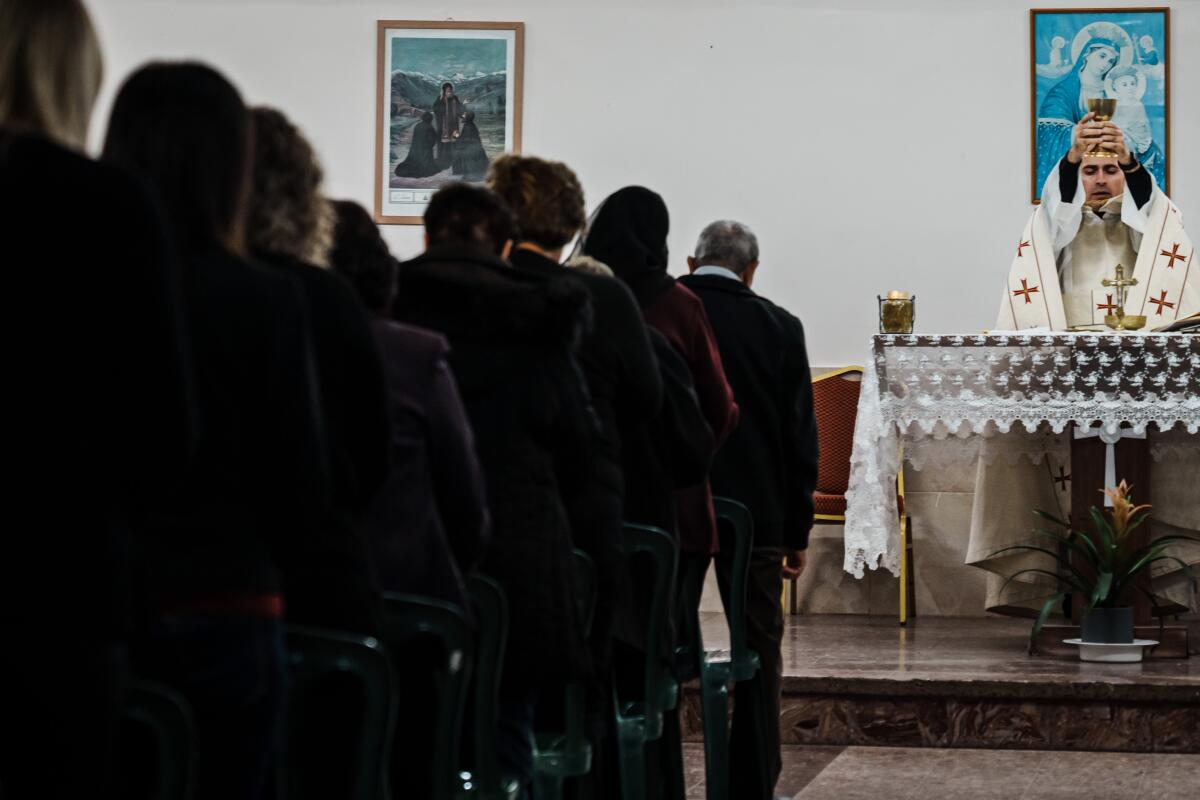


1. Father Sandi Habib leads a Sunday prayer service in a makeshift worship area in the basement of the Mar Maroun Maronite Church in Jish, Israel. 2. Books during a prayer service. 3. Georgette Sliman, 75, prays during the service. (Marcus Yam / Los Angeles Times)
During Israel’s weeklong cease-fire with Hamas in November, when 110 hostages were freed, Hezbollah mostly honored the truce, renewing rocket attacks only after the deal collapsed.
“Neither Hezbollah nor Iran are interested in a wider war,” Mizrahi said.
For its part, the Israeli army is “ready at any moment to go on the offensive in the north,” Israeli army chief of staff Lt. Gen. Herzi Halevi said during a Dec. 5 news conference. Halevi added that Israel was exploring both diplomatic and military options to deal with the Hezbollah threat.
Hezbollah leader Hassan Nasrallah boasted in a November speech that its attacks in the north have forced Israel to divert a large amount of its army, navy, and air force resources away from Gaza, which has helped the Palestinians there.
The group has also sought to pressure the international community into intervening in the Gaza conflict by demonstrating how violence could spread into a regional war.

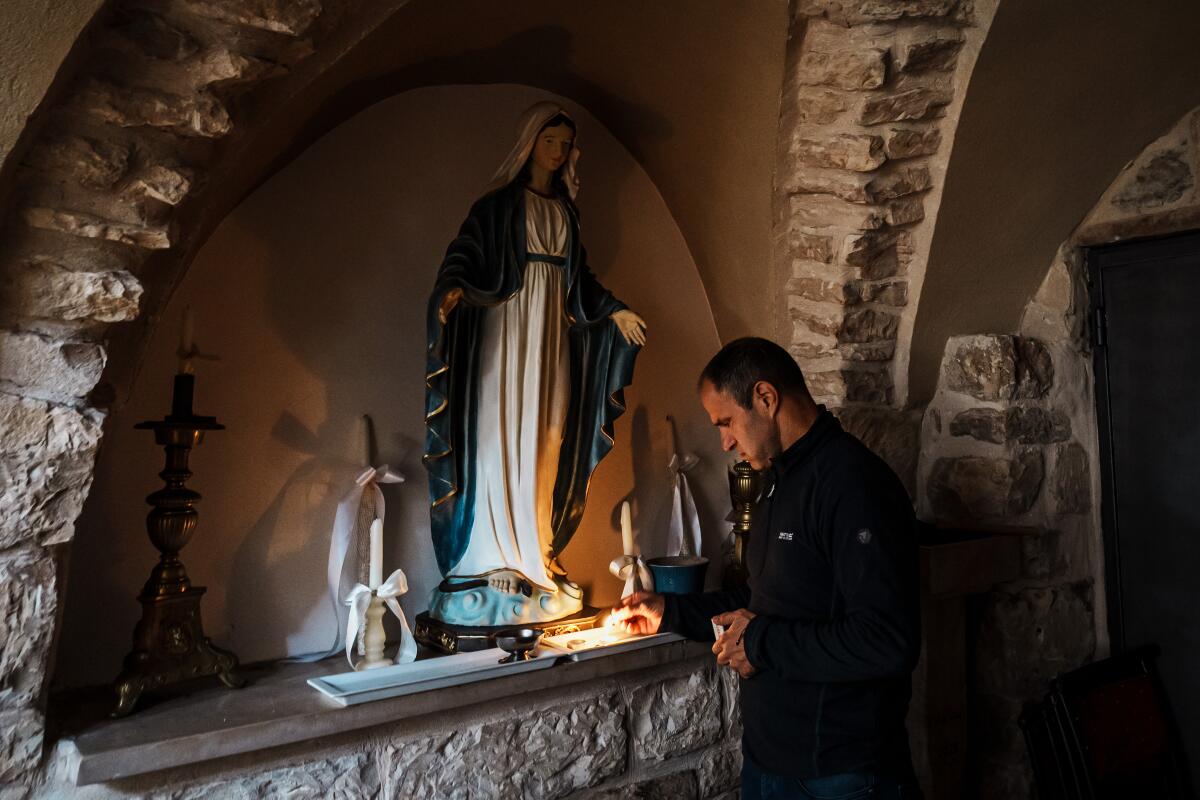
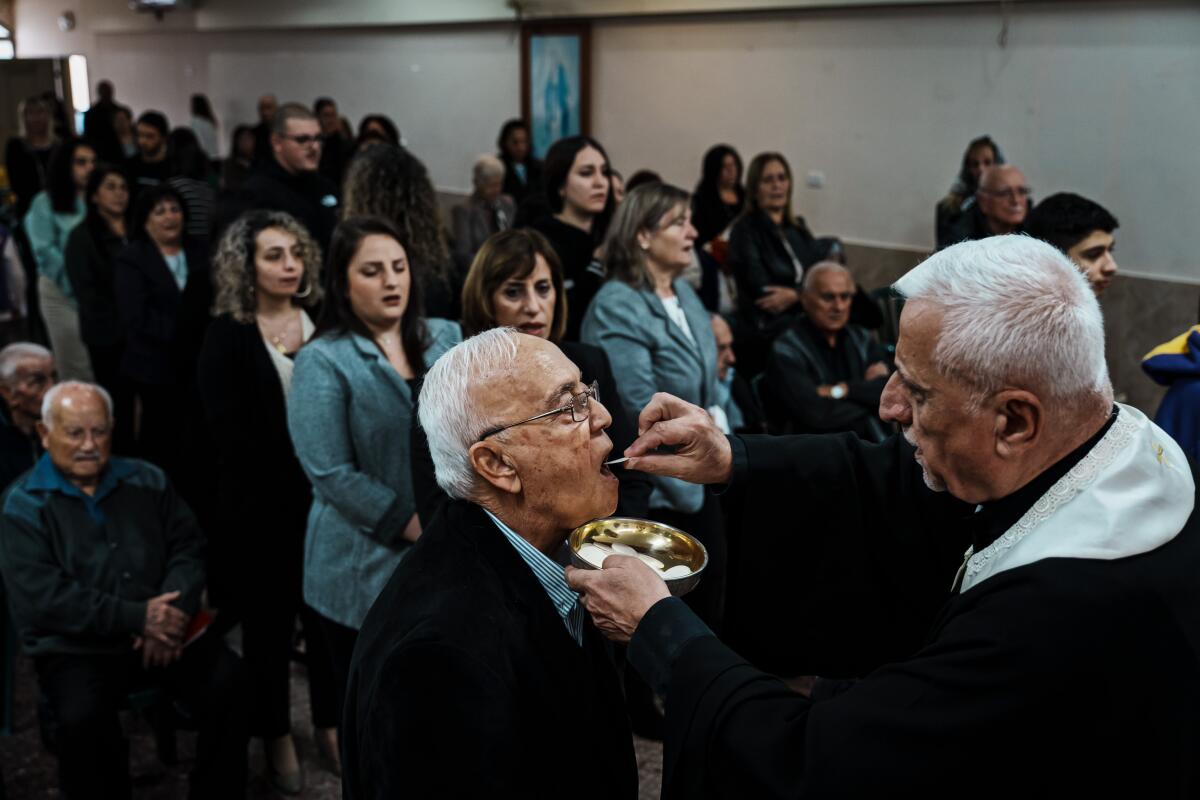
1. Congregants raise their hands during prayer service at Mar Maroun Maronite Church. 2. Shadi Khaloul lights a candle in an ancient Maronite church in a national park in Bar’am, Israel. 3. Father Bishara Sliman offers sacramental bread to the congregation at Mar Maroun Maronite Church in Jish, Israel. (Marcus Yam / Los Angeles Times)
Both Mizrahi and Khaloul said that for Israelis to regain their sense of security in the north, Hezbollah fighters must be pushed back from their footholds along the border, creating a buffer zone controlled by United Nations forces and the Lebanese army.
Evacuated families from the north have railed against the Israeli government, fearful they will be forced to return to a reality where they are living just a couple of miles from a militant group that is better funded, better organized and better armed than Hamas.
Mizrahi cited the Litani River, whose western branch runs parallel to the border about 13 miles north, as a psychological boundary for Israelis. If Hezbollah were contained north of the Litani River, that would restore some feeling of safety for Israelis, she said.
This is also the boundary that was agreed upon in United Nations Resolution 1701, which helped end the 2006 war between Israel and Lebanon.
But Resolution 1701 has been mostly ignored as Hezbollah has crept closer to the border in recent years. Militants now operate so close to the border that Israelis can see them with their bare eyes.
Hezbollah “is just one mile from our homes, maybe two miles from our homes,” Khaloul said. “We don’t need another Oct. 7 to happen here.”
Lidman is a special correspondent. Times staff writer Nabih Bulos in Beirut contributed to this report.
More to Read
Sign up for Essential California
The most important California stories and recommendations in your inbox every morning.
You may occasionally receive promotional content from the Los Angeles Times.
